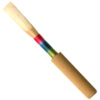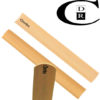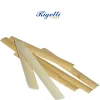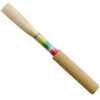I’m going to reveal how we clean the reeds we sell and how you can achieve a reasonable level of cleanliness with your own reeds.
The nooks and crannies in double reeds make cleaning challenging. Complete sanitization is not a realistic goal. We offer sincere thanks to Adam Schwalje, MD, DMA, for helping us to understand more about reed cleanliness. According to Dr. Schwalje, while there is no specific evidence regarding the effective removal of virus materials from reeds, he has published recommendations based on conversations with Dr. Peter W Krug, a senior scientist affiliated with the NIH, or National Institutions of Health. We have based much of what is said here on those published comments.
Remember, we are after a reasonable level of cleanliness. Just as in the playing of music, there is no perfect way to do this.
New Reeds:
We start by diluting a disinfectant such as Sterisol as directed. We make up about a pint at a time and use this to initially soak the cane. Once a reed has been assembled and is ready for final scraping and testing we use that type of solution to wet the reed. After the reed is adjusted and ready to play, we soak it in that solution for about 10 minutes. We then shake out extra moisture and leave the reed out in a protected area to dry for a minimum of three days. We package it using a mask and gloves. Once a player receives the reed, we recommend they let the reed “air out” for a few days before use.
The main agent in Sterisol is “Hyamine 1622” which is USDA approved for this use. Sterisol is safe for humans and when diluted, does not turn reeds colors, or affect the flavor.
If you don’t have Sterisol or an equivalent, consider using something that kills viruses. Any cleaner or astringent is better than nothing. Mouthwash may help a little. Isopropyl alcohol at 91% is somewhat effective, but may dry out the fibers of your reed. Do not use anything with a higher than 91% alcohol base. Do not use bleach or anything that is not safe for human consumption. Letting the reed dry completely and thoroughly appears to be the one method that will achieve a reasonable state of cleanliness.
Used Reeds
Use Sterisol or an equivalent each time you put your reed away, and before each use. We also clean our personal reeds every time we use them by running them upside down under hot tap water for a few minutes. This removes whatever buildup is left inside the reed, allowing the reed to vibrate more freely. Some people use a pipe cleaner or feather for this, but we prefer straight water, as it leaves no fibers behind and can probably get further into the nooks and crannies.
Our strong recommendation is to not share reeds. During normal times, most teachers test and share reeds with students. If you are teaching in person, or sharing reeds, consider this an excellent time to have your students start making, testing, and adjusting their own reeds.
We welcome your feedback and thoughts.
Please add your ideas, comments, and concerns below.








Good article, it is very instructive. Where I live this product does not exist, can I use bleach? Thanks!! Enzo.-
NO BLEACH!!
Hi Enzo,
Bleach is pretty toxic if it gets in your system. Don’t use it.
Do you have rubbing alcohol or isopropyl alcohol available? It may have a different name in Argentina. It may be called “alcohol para frotar”. You can dip reeds in this and then rinse them with water. Alcohol will dry out the cane, which is why it is good to rinse them after. Better to be dried out than dangerous.
I just used bleach on a chanter reed with nold. Toxicity isn’t nearly what it is in a swimming pool.
Sounds like you’re experienced in doing this. For anyone that wants to emulate you, please remember that ingesting bleach is dangerous when done in any quantity. Do you brush off the mildew as well?